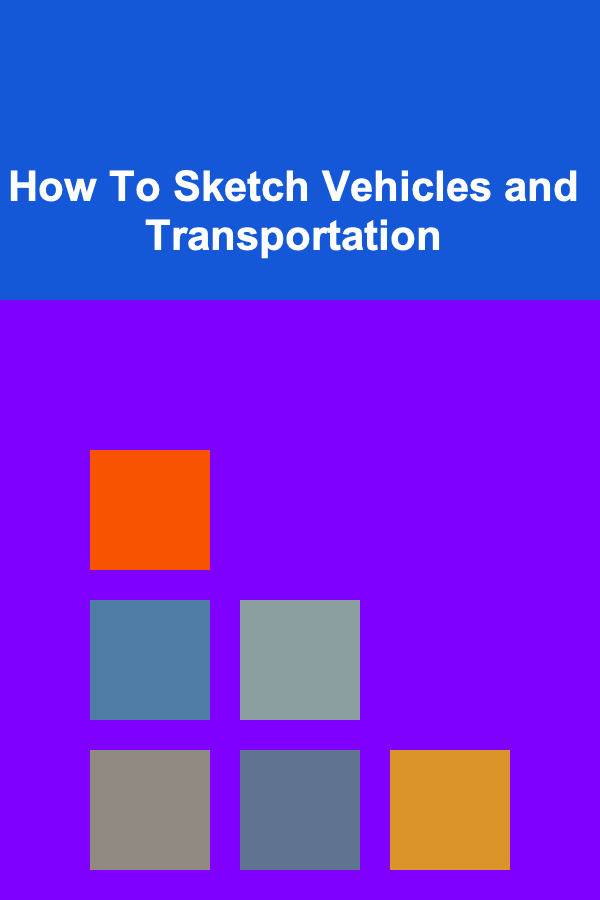
How To Sketch Vehicles and Transportation
ebook include PDF & Audio bundle (Micro Guide)
$12.99$6.99
Limited Time Offer! Order within the next:

Sketching vehicles and transportation systems can be a rewarding and intricate pursuit, whether you're a hobbyist, a budding designer, or an artist looking to expand your skills. The realm of vehicles is vast, ranging from everyday cars to futuristic spaceships, and mastering the ability to represent these machines can add great depth to your artistic repertoire. This article will guide you through the process of sketching vehicles, providing useful techniques, tips, and principles to improve your work.
Understanding the Basics of Vehicle Design
Before diving into specific techniques for sketching vehicles, it's essential to understand some basic principles of design that apply to all forms of transportation, whether land, sea, or air. Vehicles are designed with a purpose in mind, and the way we sketch them should reflect their functional and aesthetic characteristics.
Function and Form
Each type of vehicle, whether a car, airplane, or bicycle, has unique functional features that determine its form. A sports car, for example, has a streamlined, aerodynamic design to facilitate speed, while a cargo truck has a bulkier form to prioritize cargo space and stability.
Understanding the purpose of the vehicle will allow you to emphasize the right aspects of its design when sketching it. Start by asking:
- What is the vehicle's purpose? (e.g., speed, efficiency, cargo)
- What are the key features that define its design? (e.g., wheels, engine placement, aerodynamics)
This understanding will guide your initial sketch and help you focus on the right details.
Perspective and Proportions
To create a realistic vehicle sketch, it is crucial to understand how vehicles appear from different perspectives. In technical drawing, this is known as perspective drawing, where objects are drawn to reflect the way they appear in three-dimensional space. Vehicles are often depicted from one of the following perspectives:
- Front view: This shows the vehicle's design as seen from the front, often used for cars and trucks.
- Side view: A lateral view, commonly used to display the overall length and shape of a vehicle.
- Three-quarter view: This angle shows the vehicle from an offset angle, displaying both the side and the front of the vehicle. It's a highly dynamic angle that provides depth and visual interest.
- Top view: A bird's eye perspective, often used for diagrams and detailed drawings of the vehicle's roof and top features.
Proportions
Vehicles typically have standard proportions that are important to keep in mind. For instance:
- The wheels of most vehicles will typically be about one-fourth to one-fifth of the vehicle's total length, depending on the type.
- The length-to-width ratio will vary depending on the type of vehicle (e.g., a car will have a different length-to-width ratio compared to a bus).
- The height of the vehicle: The height of the vehicle is often based on its function. A sports car will be lower to the ground, while a truck will be taller to accommodate cargo.
Having a good sense of proportions will prevent your vehicle from appearing too squat or elongated, making it look more realistic.
Tools and Materials
While mastering sketching techniques is essential, having the right tools can make a significant difference in the quality and ease of your sketches. Here are some essential materials you will need:
Pencils
Pencils are the most basic tool for sketching, but they are crucial. You will need a range of pencils to achieve different effects:
- HB pencils for general sketches and outlines.
- 2B, 4B, and 6B pencils for darker, heavier lines and shading.
- H and 2H pencils for lighter lines and finer details.
Paper
Use smooth, high-quality sketching paper for clean lines and effective shading. You can also experiment with textured paper if you're looking for a more rough, sketch-like effect.
Ruler
A ruler is useful for drawing straight lines, especially when working on vehicles with defined edges, like trucks or buses.
Erasers
A good eraser is essential for correcting mistakes and refining your sketches. Use a kneaded eraser for more control and a precision tip eraser for detailed work.
Markers, Pens, and Ink
Markers and pens can be used for finalizing your vehicle sketches, especially if you're aiming for a bold, clean look. Use fine-liner pens for outlines and thicker markers for shading and adding texture.
Software Tools (Optional)
If you are comfortable with digital sketching, programs like Adobe Photoshop, Corel Painter, or Procreate offer a wide range of brushes and tools that mimic the natural feel of sketching.
Step-by-Step Guide to Sketching Vehicles
Now that we've covered the basics, let's go through a step-by-step guide to sketching a vehicle. In this example, we'll sketch a car, but these steps can be applied to other types of transportation as well.
Step 1: Basic Framework
Start by drawing the basic shape of the vehicle. For a car, you'll begin with a simple rectangle to represent the body. This rectangle will help you determine the car's length and width. Draw another rectangle or an oval to represent the wheels. Keep the proportions in mind --- the length of the car should be about 3 to 4 times its width.
Use light, loose lines to create the basic structure, as you'll refine this in later steps.
Step 2: Define the Wheels
Next, sketch the wheels of the vehicle. Make sure they are placed in the correct position. For most vehicles, the front wheels should be slightly closer to the front of the body, while the rear wheels are slightly closer to the back.
Ensure that the wheels are proportionate to the vehicle, paying attention to the wheelbase --- the distance between the front and rear axles.
Step 3: Add the Roof and Windows
Now, sketch the roof and windows. For a car, start by drawing the roofline, which is often slightly curved or slanted, depending on the type of vehicle (e.g., a sedan or a sports car). The windows should be proportionate to the body of the car, and their placement will help define the character of the vehicle.
Step 4: Refine the Details
Now that the basic structure is in place, begin adding details such as the headlights, grille, door lines, side mirrors, and bumpers. These details help to characterize the vehicle and make it unique.
For the wheels, add hubcaps or rims, and add the necessary lines for the tires. Details such as the car's exhaust system, tailpipes, or roof rails can also be included, depending on the vehicle.
Step 5: Shading and Texturing
Shading is what gives your vehicle sketch depth and dimension. Observe how light falls on the vehicle and use shading techniques to reflect this. Start shading lightly, then build up layers for darker areas. You can use hatching (parallel lines) or cross-hatching (intersecting lines) to add texture.
For chrome or reflective surfaces like the windows or hubcaps, use lighter shading and create reflective highlights.
Step 6: Finalize the Drawing
Once the shading is complete, review your sketch and add any finishing touches. Clean up unnecessary lines, refine details, and enhance the overall look with a final pass of darker lines.
Step 7: Optional Color
If you wish to add color, use colored pencils, markers, or digital tools to paint your vehicle. For a more realistic look, apply shading and highlights to give the vehicle a three-dimensional appearance.
Advanced Techniques for Vehicle Sketching
Once you've mastered the basic vehicle sketch, you can experiment with more advanced techniques to make your drawings stand out.
Dynamic Poses and Action Shots
To create more dynamic sketches, draw vehicles in motion. This could include showing a car speeding down a road, a plane taking off, or a bike navigating through a tight corner. To capture motion, you can blur the wheels, add speed lines, or tilt the vehicle to show acceleration.
Incorporating the Environment
Another technique to add depth to your vehicle sketches is by including the environment around the vehicle. You could sketch a car driving on a highway, a bus navigating a crowded city street, or a boat floating on the water. The context of the vehicle will not only enhance its design but will also tell a story about its purpose.
Perspective Challenges
As you advance in vehicle sketching, you'll want to experiment with more challenging perspectives, such as high or low angles, or a view from above or below the vehicle. These angles require a strong understanding of perspective and can add dramatic flair to your sketches.
Vehicle Modifications and Concept Sketching
Vehicle design can be an exciting area to explore, especially if you are interested in conceptual or futuristic transportation. Try sketching vehicles that don't exist yet. Consider how futuristic technologies, like self-driving cars or flying taxis, might affect their design. This can involve modifying existing vehicles or imagining entirely new concepts.
Common Mistakes to Avoid
While sketching vehicles, there are some common mistakes that can affect the accuracy and quality of your drawings:
- Incorrect proportions: Pay attention to the size of the wheels and how they relate to the vehicle body.
- Lack of perspective: Vehicles should be drawn with the correct vanishing points to create a realistic sense of depth.
- Overlooking details: Details, like door handles, side mirrors, or exhaust pipes, add realism and should not be omitted.
- Unbalanced shading: Improper shading can flatten the drawing. Ensure the light source is consistent throughout the sketch.
Conclusion
Sketching vehicles is a skill that takes time, patience, and practice to master. By understanding the basics of vehicle design, perspective, and proportions, and by following a structured approach to sketching, you can improve your ability to depict transportation in all its forms. Whether you're sketching a classic car, a modern motorcycle, or an imaginative futuristic spaceship, the techniques in this article will help you create accurate, dynamic, and engaging vehicle sketches. With dedication and a commitment to practice, you'll soon see significant improvements in your vehicle drawing skills.

How to Make Your Home Feel Like a Retreat with Soft Lighting
Read More
How to Store Seasonal Items Efficiently
Read More
How to Utilize LinkedIn Video Content to Showcase Your B2B Dropshipping Products
Read More
How To Interpret Mythological Birds and Their Meanings
Read More
How to Build a Road Trip Checklist for Van Life Beginners
Read More
10 Tips for Drawing Expressive Hands
Read MoreOther Products

How to Make Your Home Feel Like a Retreat with Soft Lighting
Read More
How to Store Seasonal Items Efficiently
Read More
How to Utilize LinkedIn Video Content to Showcase Your B2B Dropshipping Products
Read More
How To Interpret Mythological Birds and Their Meanings
Read More
How to Build a Road Trip Checklist for Van Life Beginners
Read More